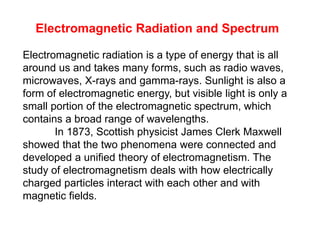
electromagnetic spectrum.ppt
- 1. Electromagnetic Radiation and Spectrum Electromagnetic radiation is a type of energy that is all around us and takes many forms, such as radio waves, microwaves, X-rays and gamma-rays. Sunlight is also a form of electromagnetic energy, but visible light is only a small portion of the electromagnetic spectrum, which contains a broad range of wavelengths. In 1873, Scottish physicist James Clerk Maxwell showed that the two phenomena were connected and developed a unified theory of electromagnetism. The study of electromagnetism deals with how electrically charged particles interact with each other and with magnetic fields.
- 2. In terms of the modern quantum theory, electromagnetic radiation is the flow of photons (also called light quanta) through space. Photons are packets of energy that always move with the universal speed of light.
- 3. Properties of EMR Wavelength: the wavelength is the length of one complete wave cycle which can be measured as the distance between two successive wave peaks. Frequency: frequency refers to the number of cycles of a wave passing a fixed point per unit of time. it is generally measured in hertz(Hz). The frequency is inversely proportional to wavelength. Means higher wavelength lower frequency. Amplitude The amplitude (a) of a wave is the distance from the centre line (or the still position) to the top of a crest or to the bottom of a trough.
- 4. Electromagnetic Waves •Transverse waves without a medium! •(They can travel through empty space)
- 7. Electromagnetic radiation spans an enormous range of wavelengths and frequencies. This range is known as the electromagnetic spectrum, The electromagnetic spectrum is generally divided into seven regions, in order of decreasing wavelength and increasing energy and frequency. The common designations are radio waves, microwaves, infrared (IR), visible light, ultraviolet (UV) light, X-rays and gamma-rays. Radio waves Radio waves are at the lowest range of the electromagnetic spectrum, with frequencies of up to about 30 billion hertz, or 30 gigahertz (GHz), and wavelengths greater than about 0.4 inch (10 millimeters). Radio is used primarily for communications, including voice, data and entertainment media. Microwave fall in the range of the electromagnetic spectrum between radio and IR. They have frequencies from about 3 GHz to 30 trillion hertz, or 30 terahertz (THz), and wavelengths of about 0.004 to 0.4 inch (0.1 to 10 mm). Microwaves are used for high-bandwidth communications and radar, as well as for a heat source for microwave ovens and industrial applications.
- 8. Infrared Infrared is in the range of the electromagnetic spectrum between microwaves and visible light. IR has frequencies from about 30 to 400 THz and wavelengths of about 0.00003 to 0.004 inch (740 nanometers to 100 micrometers). IR light is invisible to human eyes, but we can feel it as heat if the intensity is sufficient. Visible light Visible light is found in the middle of the electromagnetic spectrum, between IR and UV. It has frequencies of about 400 to 800 THz and wavelengths of about 0.000015 to 0.00003 inch (380 to 740 nanometers). More generally, visible light is defined as the wavelengths that are visible to most human eyes. Ultraviolet Ultraviolet light is the range of the electromagnetic spectrum between visible light and X-rays. It has frequencies of about 8 × 1014 to 3 x 1016 Hz and wavelengths of about 0.0000004 to 0.000015 inch (10 to 380 nanometers). UV light is a component of sunlight, but it is invisible to the human eye. It has numerous medical and industrial applications, but it can damage living tissue.
- 9. X-rays X-rays are roughly classified into two types: soft X-rays and hard X- rays. Soft X-rays make up the range of the electromagnetic spectrum between UV and gamma-rays. Soft X-rays have frequencies of about 3 × 1016 to 1018 Hz and wavelengths of about 4 × 10−7 to 4 × 10−8 inch (100 picometers to 10 nanometers). Hard X-rays occupy the same region of the electromagnetic spectrum as gamma-rays. The only difference between them is their source: X-rays are produced by accelerating electrons, while gamma-rays are produced by atomic nuclei. Gamma-rays Gamma-rays are in the range of the spectrum above soft X-rays. Gamma-rays have frequencies greater than about 1018 Hz and wavelengths of less than 4 × 10−9 inch (100 picometers). Gamma radiation causes damage to living tissue, which makes it useful for killing cancer cells when applied in carefully measured doses to small regions. Uncontrolled exposure, though, is extremely dangerous to humans.
- 11. RADIO WAVES •Have the longest wavelengths and lowest frequencies of all the electromagnetic waves.
- 12. MICROWAVES •Have the shortest wavelengths and the highest frequency of the radio waves.
- 13. VISIBLE LIGHT •Shorter wavelength and higher frequency than infrared rays. •Electromagnetic waves we can see. •Longest wavelength= red light •Shortest wavelength= violet (purple) light
- 14. ULTRAVIOLET RAYS •Shorter wavelength and higher frequency than visible light •Carry more energy than visible light
- 15. X- RAYS •Shorter wavelength and higher frequency than UV- rays •Carry a great amount of energy •Can penetrate most matter.
- 16. GAMMA RAYS •Shorter wavelength and higher frequency than X- rays •Carry the greatest amount of energy and penetrate the most.